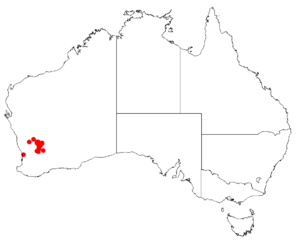Barbalin boronia facts for kids
Quick facts for kids Barbalin boronia |
|
|---|---|
| Conservation status | |
| Scientific classification | |
 |
|
| Occurrence data from Australasian Virtual Herbarium |
The Barbalin boronia (scientific name: Boronia adamsiana) is a special plant. It belongs to the citrus family, called Rutaceae. This plant is found only in a small part of Western Australia, in the south-west. It grows as a straight, hairy bush with leaves that have three parts. Its flowers are usually pink or white and have four petals.
Contents
About the Barbalin Boronia
The Barbalin boronia is a type of shrub or bush. It can grow to be about 0.3 m (1 ft) to 1 m (3 ft) tall. This plant has many branches. Its branches, leaves, and even parts of its flowers are covered in thick, grey, woolly hairs.
Leaves and Flowers
The leaves of the Barbalin boronia are interesting. Each leaf is made up of three smaller parts, called leaflets. The leaflet at the end is shaped like an oval or a spear. It is about 5 mm (0.2 in) to 17 mm (0.7 in) long. It is also about 1.5 mm (0.06 in) to 5 mm (0.2 in) wide. The two leaflets on the sides are similar but a little bit shorter.
The flowers are either pink or white. They grow one by one where the leaves meet the stem. Each flower sits on a tiny stalk, called a pedicel, which is only about 0.5 mm (0.02 in) to 1 mm (0.04 in) long.
Each flower has four sepals. Sepals are like small leaves that protect the flower bud. These sepals are egg-shaped or triangular. They are about 3 mm (0.1 in) to 4.5 mm (0.2 in) long. They are also about 1.5 mm (0.06 in) to 2 mm (0.08 in) wide. As the fruit grows, these sepals get bigger.
The four petals of the flower are about 4 mm (0.16 in) to 5 mm (0.20 in) long. They are also about 2 mm (0.079 in) to 2.5 mm (0.098 in) wide. Like the sepals, the petals also grow larger as the fruit develops.
The flower has eight stamens. Stamens are the parts that produce pollen. These stamens are different lengths. The ones closer to the sepals are longer than the ones closer to the petals.
The Barbalin boronia flowers from July to October. Its fruits are hairy and small. They are about 4 mm (0.2 in) long and 2 mm (0.08 in) wide.
Naming the Barbalin Boronia
The scientific name Boronia adamsiana was first officially described in 1890. This was done by a famous botanist named Ferdinand von Mueller. He published his description in a scientific paper called Proceedings of the Linnean Society of New South Wales.
The plant was named after Mary Annie Adams (1874-1931). She was born in Western Australia and collected plant samples for Mueller. The second part of the name, adamsiana, is called the specific epithet. It honors her work.
Where the Barbalin Boronia Lives
The Barbalin boronia grows in areas with scrub and heath plants. It can be found on flat lands and along road reserves. These areas are mainly in the Avon Wheatbelt and Coolgardie regions of Western Australia. You can find it roughly between the towns of Beacon, Trayning, and the area around Mount Marshall.
Protecting the Barbalin Boronia
The Barbalin boronia is considered a vulnerable plant. This means it is at risk of disappearing. The Australian Government lists it as vulnerable under the Environment Protection and Biodiversity Conservation Act 1999. The Department of Environment and Conservation (Western Australia) also calls it "Threatened Flora."
Threats to the Plant
There are several things that threaten the Barbalin boronia:
- Grazing animals: Farm animals like sheep or cattle eating the plants.
- Fire: Fires that happen too often or at the wrong time can harm the plants.
- Land use: Other ways people use the land, like farming or building, can destroy its habitat.
- Clearing land: Removing large areas of natural plants for other purposes.


